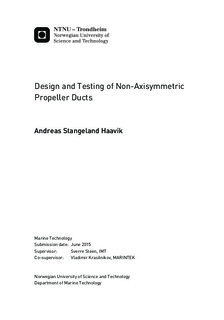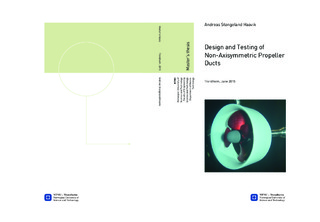| dc.description.abstract | Ducted propellers are widely used on large range of vessels, especially for increased thrust, which is important on vessels like anchor handlers and trawlers.
In the later years new manufacturing techniques have been developed for production of propeller ducts. For that reason it might be easier and less costly to manufacture ducts with customized geometry. Propellers have since long time been customized to a given wake field. This type of customizing is suited for ducts as well. The main goal is to design a duct that generates homogenous flow into the propeller, as well as increasing the efficiency. This shall reduce the risk of cavitation. Cavitation is considered to only have negative contributions, like reduction of thrust and generation of noise and vibration.
A design procedure for the design of non-axisymmetric propeller ducts is developed. The script Haavik's model reads a given wake field from an arbitrary vessel, and divide the duct into sections. Then the script proposes a duct that consisting of different duct cross sections. The duct will accelerate or decelerate the flow, depending on the wake field, so the flow into the propeller becomes homogeneous. The duct cross sections are presented in a duct library.
During this master thesis two non-axisymmetric ducts are designed and tested. The ducts are tested against a reference duct, the well-known and axisymmetric 19A. The following tests for comparing the ducts are performed: open water test, cavitation bucket, pictures and noise measurements. All tests are done in the cavitation tunnel at MARINTEK, Trondheim.
The open water tests shows that the efficiency is higher for the non-axisymmetric ducts, compared to the 19A. The open water tests show also that the thrust is increased and that the torque is unaffected. The results from the cavitation tests shows that bubble cavitation reduce the total thrust. Thus, the non-axisymmetric ducts are less affected by this type of cavitation, compared to the 19A.
Duct cavitation occurred only at the 19A duct. That phenomenon happened at low cavitation numbers.
As a final conclusion I mean that the tests of the non-axisymmetric ducts shows good results. The design procedure should be improved so more accurate results are obtained. The duct library should expand so the transitions between the cross sections will be smoother, thus more accurate calculations. CFD calculations might efficiently tell how the duct influences the flow into the propeller. | |

